There's a warning on the box my steam iron came in that says, "Do not iron clothes while wearing them."
This gave me pause for a few minutes, but it got me thinking about the kind of lawsuit that prompted lawyers to include an otherwise obvious warning on the box and the kind of crisis communication plan that came to exist in the aftermath.
Add that to the "pudding will get hot when heated" warning and the trademark "shower cap fits only one head" disclaimer, and you've got yourself an era in which communication plans are not only a helpful organizational tool but a very necessary one.
Successfully running a company requires clear communication across the board: with employees, customers, investors, and any other stakeholders. Any gap in communication can lead to difficulties that range from minor project blips to absolute disaster. And while they're necessary for crisis management, communication plans have plenty of other uses beyond ensuring your consumer doesn't give themselves third-degree burns.
Table of contents:
What is a communication plan?
A communication plan is your blueprint for delivering key information to appropriate stakeholders. It outlines the information that needs to be communicated, who it's meant for, the channel it's delivered through, and the folks in charge of it to ensure clear, consistent, and purposeful communication.
This document can look different depending on what it's used for. Here are some examples to give you an idea:
If I were creating a crisis communication plan for the unlikely event that someone irons their shirt while wearing it, I'd consider all the steps we'd have to take to avoid scrutiny and legal issues, like seeking medical attention, designating a spokesperson to represent our company, or press release strategies to address the issue. (I'd also consider whether the box should come with a logical analysis puzzle the user needs to solve before they can open it, but that's just me trying to fix the world one steam iron at a time.)
A marketing communication plan plays a different role. It's designed to outline responsibilities and initiatives within the grand scope of the marketing strategy to keep teams aligned and informed. One initiative I'd underline twice for our steam iron product would be to produce marketing imagery that clearly demonstrates how to iron a shirt—i.e., on an ironing board, not a body.
A product launch communication plan helps keep everyone on the same page regarding brand messaging, intended effects, and progress throughout the launch. Let's take Apple as an example. They're known for their meticulously planned and executed product launches. Their communication strategy involves creating anticipation through teaser campaigns, leveraging secrecy to build excitement, and hosting live events to unveil new products.
Bottom line: communication plans run the gamut. When it comes to format, some plans may be in a table format, outlining talking points and deadlines. Others may contain more of a narrative, meant to inform and update the reader on how a situation is being handled.
You can use a communication plan for both external and internal communication. An employee communication plan, for example, is only meant for your team's eyes. On the other hand, public relations communication plans can be used internally and can also be shared with relevant third parties for outreach and marketing purposes.
Communication plan templates
A communication plan is that one bookmark every employee clicks at the beginning of their day until they associate its main page with the smell of coffee.
Knowing what it is and why it matters is one thing, but understanding the different ways you can use a communication plan is another. Since there are so many different types of plans, I've put together a few templates to highlight the differences. Pick your (well-labeled) poison.
1. Marketing communication plan
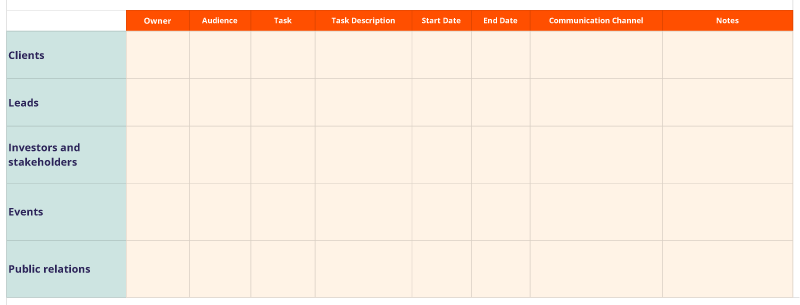
This communication plan outlines your marketing initiatives for each audience. It tracks relevant information, including the person or team in charge of the project, tasks, timeline, communication channels, audience, and notes.
It also organizes this information based on each aspect of your marketing strategy, whether it's targeting existing clients, potential leads, investors, events, or any PR third parties.
2. Crisis communication plan
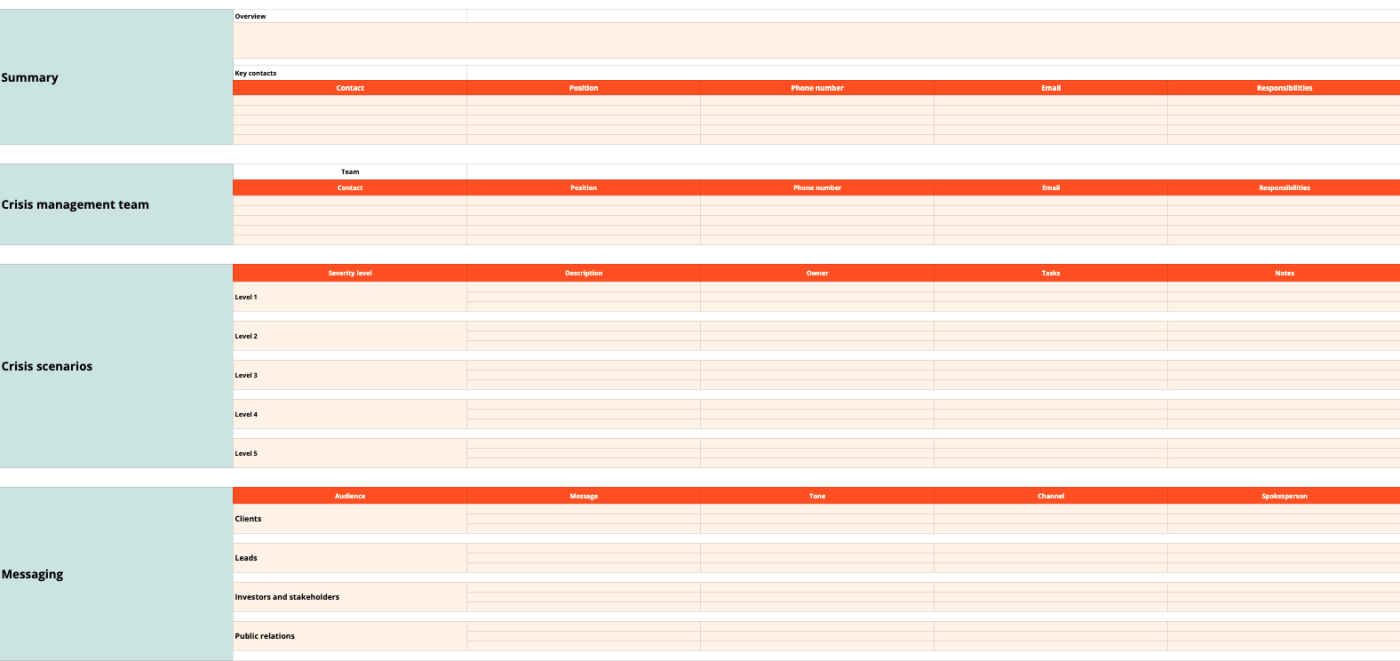
No organization is immune to unexpected and challenging situations that can potentially harm its reputation and operations. This communication plan outlines a systematic approach to addressing crises, including key team members, their responsibilities, communication channels, and the predefined strategy.
It should include clear guidelines for rapid response, methods for updating stakeholders, and ways to mitigate potential damage to the organization's image. The plan should always outline the key crisis management team, their roles and responsibilities, procedures for identifying the crisis, and how to work with media outlets and external entities.
3. Internal communication plan
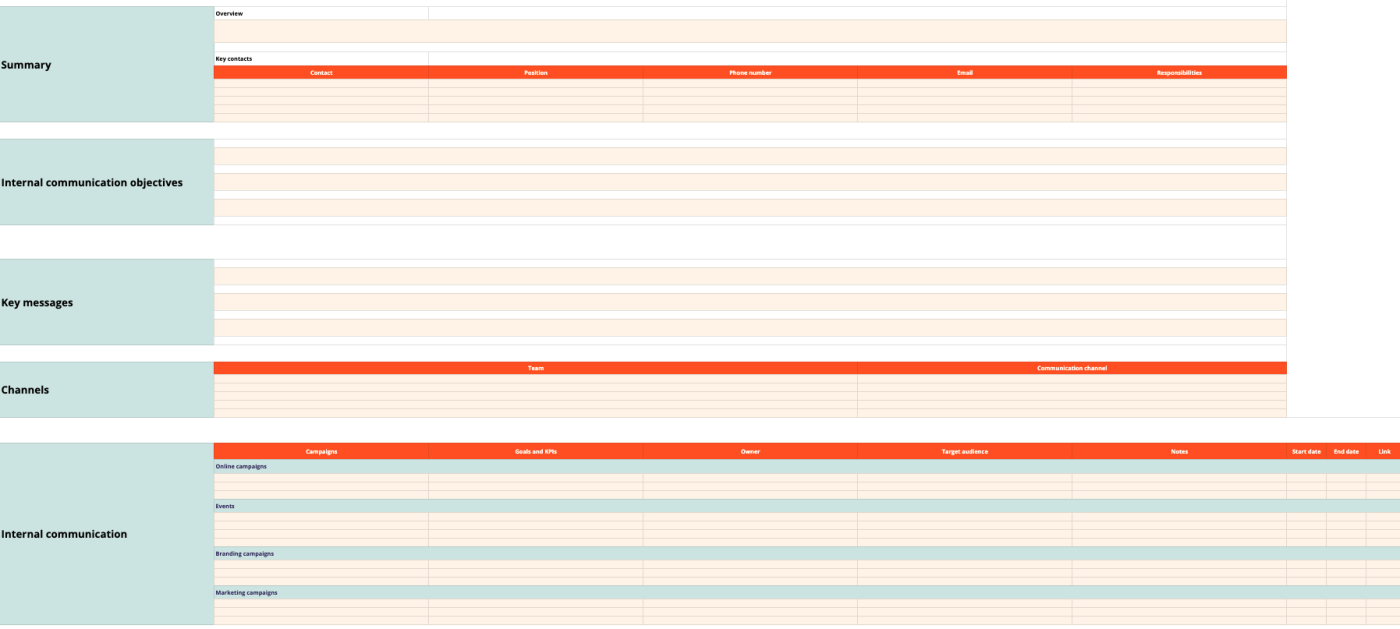
This communication plan is designed to ensure employees receive timely and relevant information, have clear visibility of organizational goals, and stay informed about key developments within the organization.
It includes details on communication channels, such as newsletters, meetings, and virtual seminars. Typically, it outlines how the leadership team communicates with employees, how frequently they can expect updates, and methods for gathering feedback to enhance internal communication across the board.
4. Social media communication plan
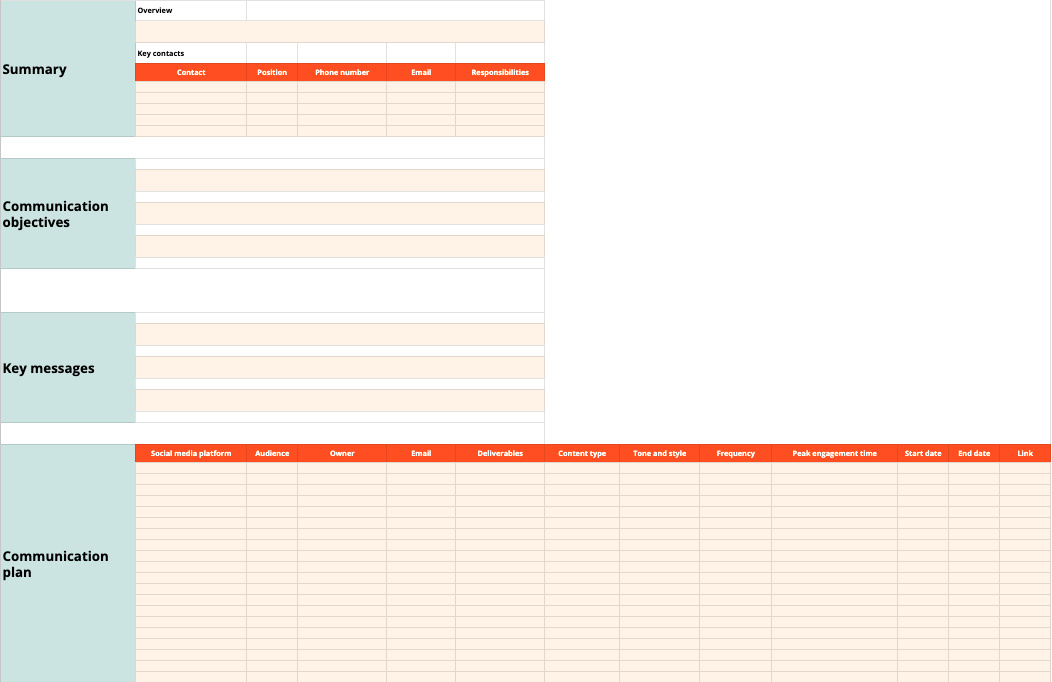
A social media communication plan guides a company's strategy in utilizing social media platforms for its communication goals. It's important for building a strong online presence, engaging with your target audience, and managing your company's reputation in the digital world.
This plan includes an overview of your social media content strategy, detailing the type of content you intend to share, how often you should publish posts, and the voice of the message.
To make the most of your social media communication plan, define the target audience on each platform, outline KPIs for measuring success, and establish helpful guidelines that can tie into your crisis communication plan and leverage social media in case of an emergency.
5. Change management communication plan
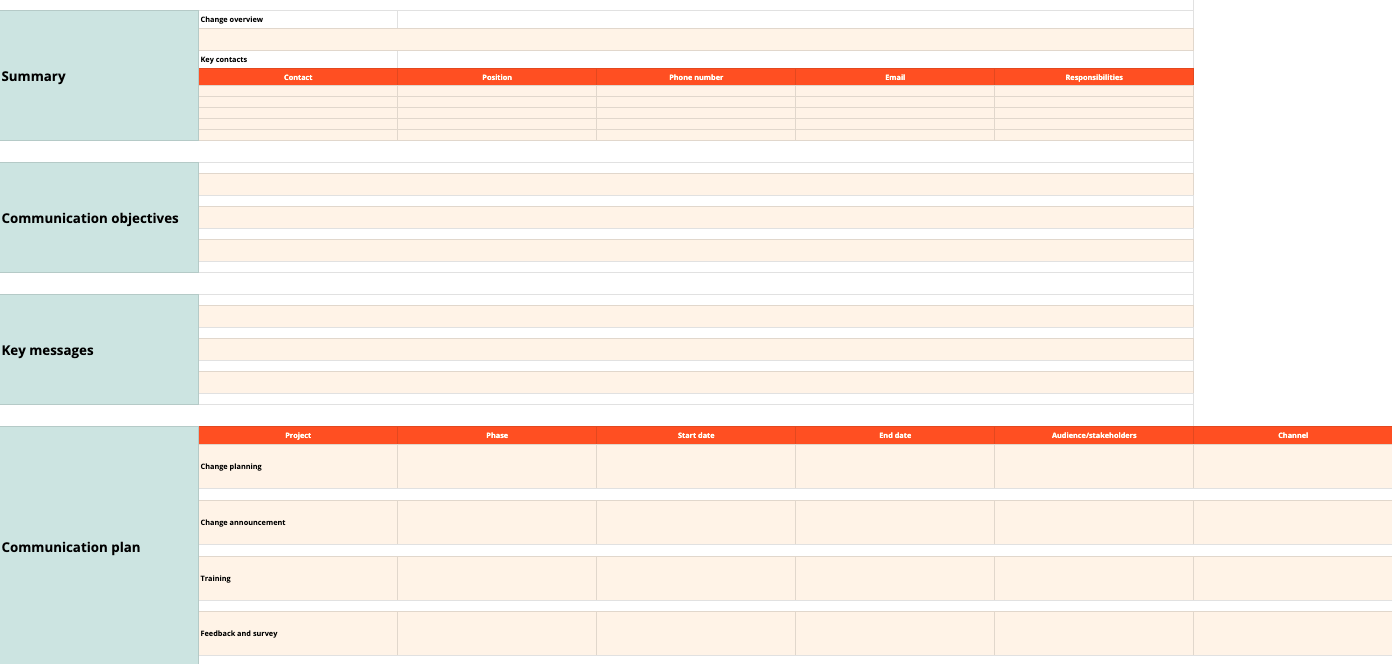
If your company goes through grand-scale change such as mergers, rebranding, restructuring, or process optimization, a change management plan is crucial for ensuring your team is informed, engaged, and supportive of the changes.
The team's going to need an explanation and a plan of action now that Janice is walking down the office toward the door marked "manager" with a big smile on her face.
Its goal is to facilitate a smooth transition and should always include clear messaging regarding the reasons for the change, the anticipated benefits, and how this could affect employees. It outlines the timeline for the change, strategies for addressing concerns, available communication channels, and any feedback regarding the process.
6. Non-profit communication plan
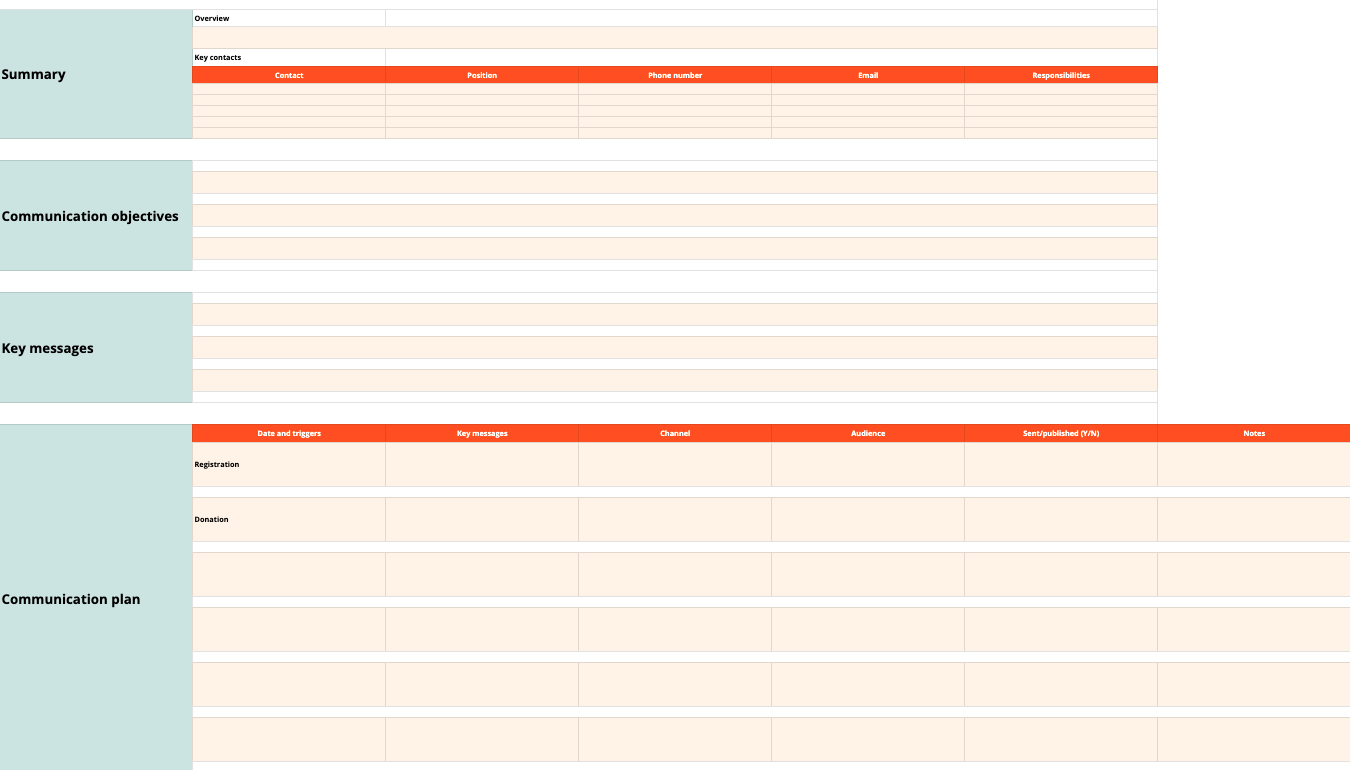
Non-profits operate differently from other organizations, and their communication plans reflect that. The document effectively conveys the non-profit's cause, engages stakeholders, and develops support.
Since it's designed to build awareness, foster donor relationships, and maintain a level of transparency about the organization's impact, a non-profit communication plan should include well-crafted messaging that aligns with the org's values, outlines the strategy for reaching and mobilizing donors, and plans how to make the most of communication channels such as social media, newsletters, and events.
For a unique touch that sets your non-profit communication plan apart, emphasize storytelling to humanize your cause and connect with your audience on an emotional level. For example, you might include an initiative that triggers an automatic email when a donor registers or makes a contribution—something that reflects their impact on the cause.
7. Product launch communication plan
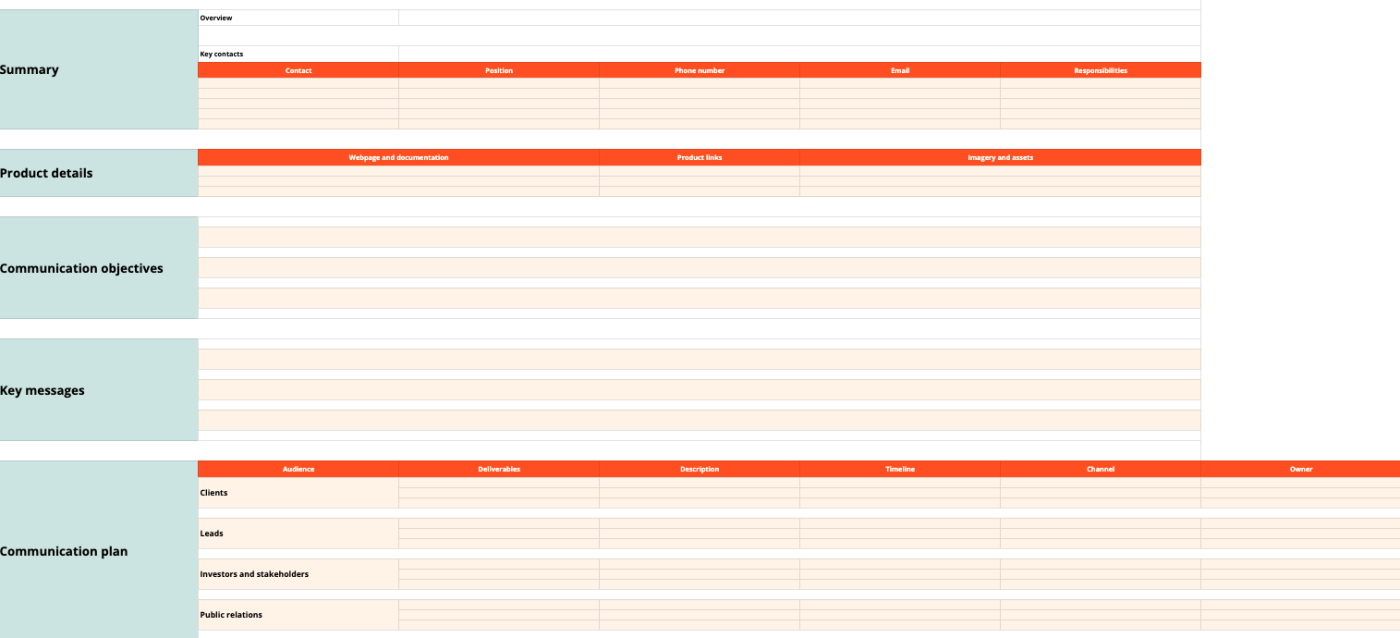
Developing a new product is a stressful and tedious process on its own. Introducing it to the world can be its own hassle, but a good communication plan can help simplify the process by creating anticipation, generating excitement, and breaking down the approach for a successful product launch.
Your plan should include key features and details about the product, the target audience, and market positioning. To nurture and engage that anticipation, you should also include a timeline for communication activities and strategies that cover the channels you intend to use, like social media, email marketing, and press releases.
To take it a step further, include messaging that addresses potential challenges and opens up the opportunity to receive feedback and gauge your customers' response to the launch.
8. Public relations communication plan
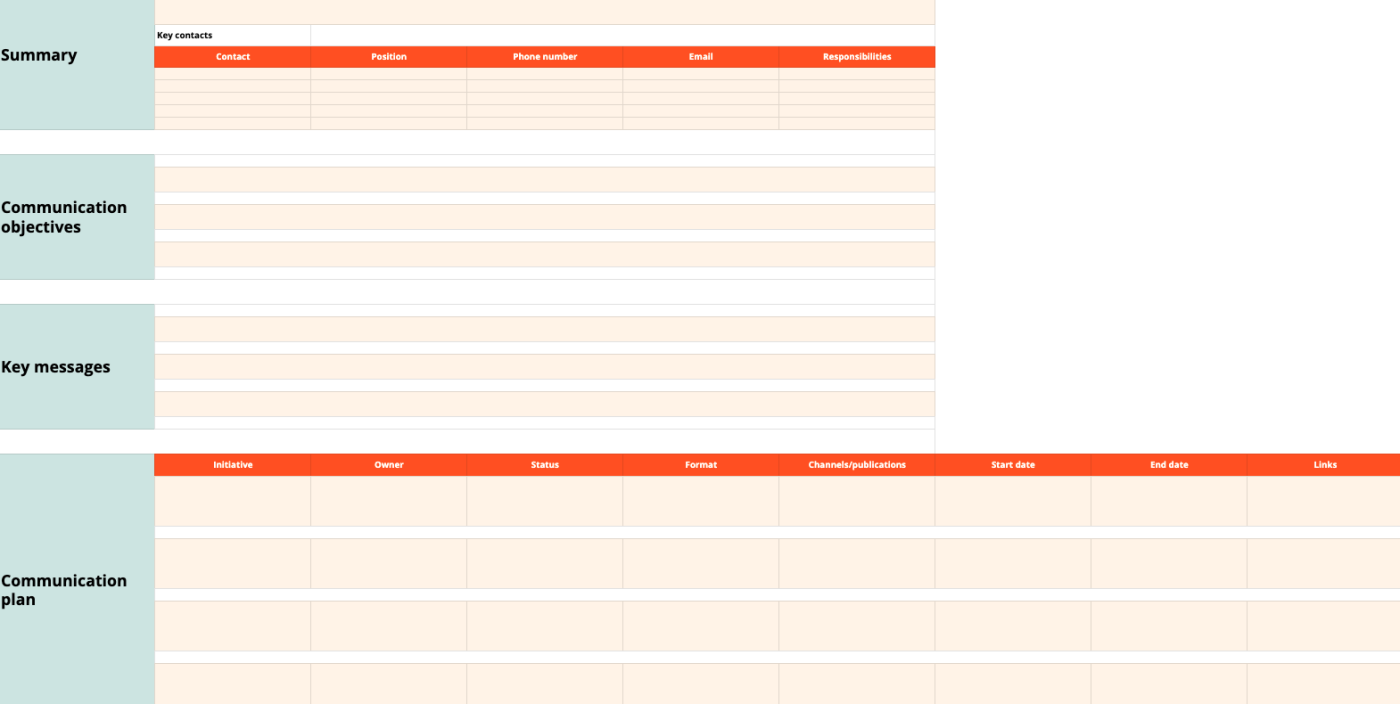
This communication plan is ideal for organizations that want to manage their brand reputation and build relationships with the public. Your brand image is an important aspect of business that can affect operations on every level, and nurturing it requires strategic communication, especially with media and public inquiries. You want the public eye to see you in your nice, freshly-ironed shirt.
A public relations communication plan includes key messaging, a media relations strategy, and a calendar of planned PR initiatives, as well as goals, target audiences, and metrics for monitoring the success of your PR efforts.
9. Employee communication plan
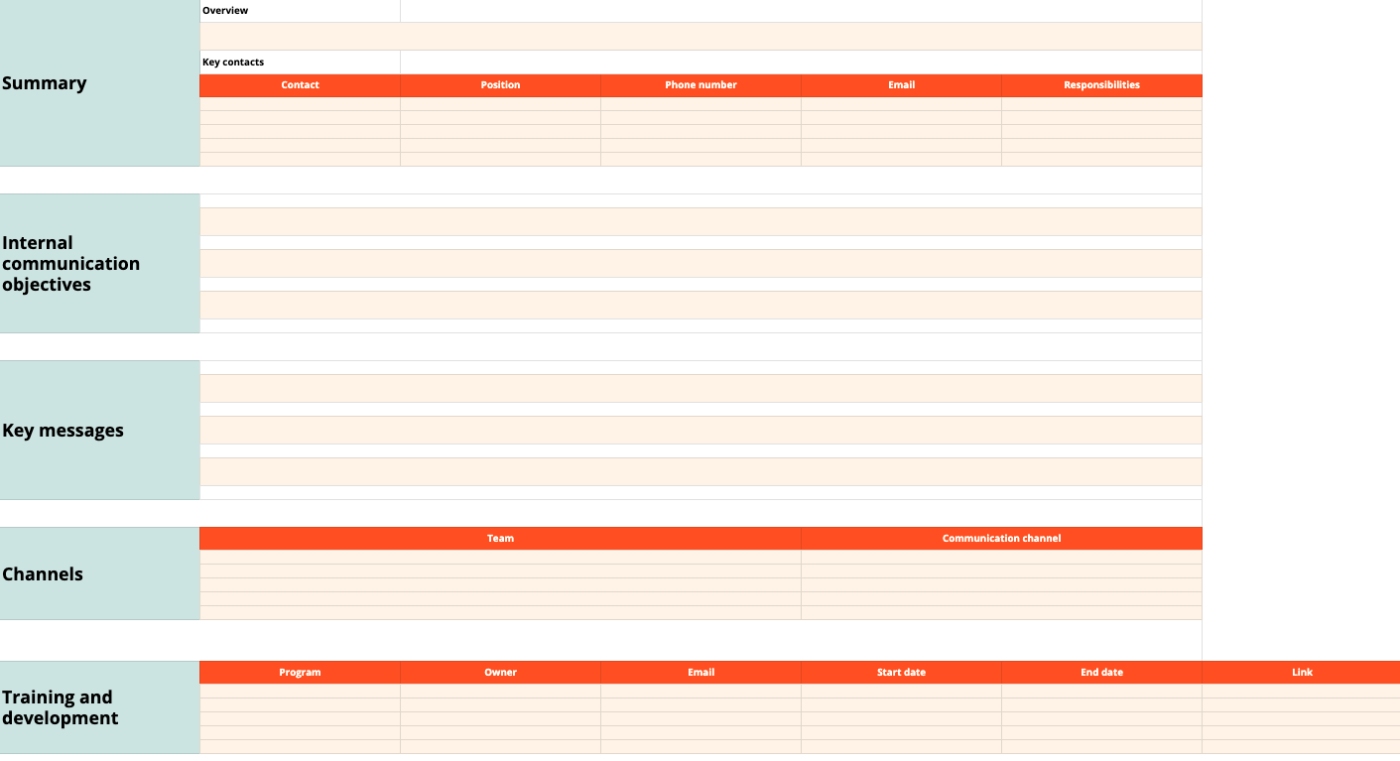
Any organization with a team bigger than six people can face major communication challenges, to say nothing of companies that employ staff in the hundreds and thousands. Company news, updates, policies, and initiatives that employees need to be aware of can be difficult to disseminate properly.
Sure, you can take your chances on a company-wide email, but it'll likely end up buried unopened somewhere in everyone's inbox, and you'll be standing there with the corporate equivalent of eating mango-scented shampoo.
An employee communication plan helps foster organizational transparency and workplace alignment within your team. It'll contribute to your company culture and enhance your employees' sense of belonging and connection to company goals.
This plan includes channels for internal communication as well as a content strategy that touches on employees' needs and concerns. While an internal communication plan focuses on the company's business goals, an employee communication plan addresses the company's internal development initiatives.
10. Event communication plan
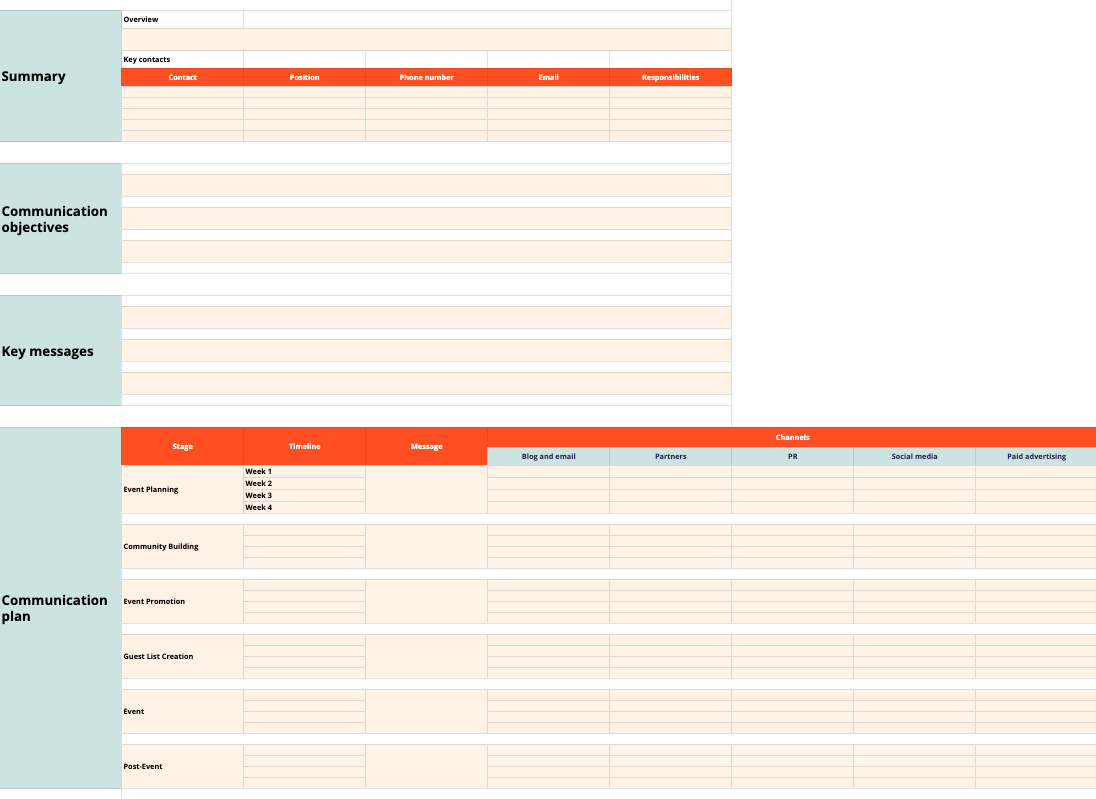
This communication plan guides your organization's efforts surrounding an event, ensuring effective promotion, coordination, and engagement. It's useful for managing the flow of information before, during, and after an event.
The plan includes key messaging, the timeline for the event's communication activities, strategies for putting channels like social media and email marketing to use, and how to properly approach inquiries and feedback from event attendees.
How to write a communication plan
Each type of communication plan contains a different set of elements, but the process of putting a communication plan together, regardless of its purpose, remains the same.
1. Set communication goals
I hate sounding like every therapist ever, but communication goals are very important. If your roommate doesn't understand that your scream of pain from the other room means you might have accidentally ironed a shirt while wearing it, help isn't coming, and your room will smell like barbeque.
Your goals can range from increasing brand awareness and engagement to notifying stakeholders about a new product launch or managing an emergency. Setting these goals beforehand lays the foundation for the entire plan and defines communication channels, messaging strategies, and evaluation metrics. Focus on setting specific, measurable, achievable, relevant, and time-bound (SMART) business objectives.
If I were ironing a shirt, I'd outline my goal for a smooth, freshly-ironed shirt free of wrinkles, and I'd prepare for that by neatly placing the shirt, being conscious of those pesky corners, and keeping it nice and aligned before getting started. In the same vein, If I were writing a communication plan that focuses on brand awareness, I'd outline goals for social media campaigns and content marketing strategies. I'd aim to increase user engagement on each social media platform by a certain percentage, increasing visibility, ad clicks, and interaction with my brand.
Clear communication goals give your organization a sense of direction and allow your team to accurately measure success, making adjustments based on tangible results.
2. Identify the audience
Each audience you're trying to reach through your communication plan will have its own unique expectations and concerns. The plan and the message within need to align with the audience's values and interests.
If you're writing for investors, the plan needs to outline your communication goals for them specifically, touching on relevant topics and important points. It would also designate how the information will be conveyed, by whom, and how to move forward if any variables were to shift.
Conduct thorough market research, and collect relevant insight into your target audience's demographics, behaviors, and preferences. What data are you sharing with your investors? What kind of information would be both relevant and important to share with them? How can you best phrase that communication so it has a positive impact?
Who's telling the board that a customer ironed their shirt while wearing it?
A good practice is to segment your audience and create detailed personas to ensure your message is not only read but understood and embraced.
3. Outline key messages
The key information you're distributing through your communication plan is a delicate balance between the organization's goals and resonance with the audience.
For example, a product launch communication plan doesn't really need your 25-year company trajectory outlined and explained. The key information here would pertain to the product itself, the process for the launch, steps to take, tasks to perform, and the timeline for the entire project.
Make your messages clear, concise, and compelling to leave a lasting impression.
4. Choose communication channels
Outline which communication channels are best suited to execute your plan. For example, an employee communication plan should utilize private internal channels like meetings, internal platforms, or emails. Product launch communication plans should leverage external channels as well, like websites, social media, newsletters, and press releases.
Choose communication channels that fit the plan and can be integrated for a cohesive communication strategy that aligns with both your company's goals and the audience's preferences. Ask yourself:
Who's meant to read this?
How can I reach them?
Is this private internal communication or is it meant for public distribution?
Which channel would have the best visibility for my audience?
5. Create a timeline
For the plan to be effective on any level, you need to outline its execution in a detailed timeline that sets the start and end dates of each initiative or item on the document.
Details such as specific dates for key events, launches, and regular updates anchor the plan and facilitate a proactive approach. The timeline is your audience's visual roadmap, and it is handy for allocating resources when you're executing your communication plan.
6. Allocate resources
Putting the plan into action will require resources like budgets and staffing needs. Even time is a resource that needs to be considered. For example, your budget should account for advertising costs, materials, technology investments, and communication channels.
Allocating resources as soon as the timeline is clear ensures the communication plan runs smoothly and delivers the intended message across all initiatives.
7. Designate responsibilities
If you run into an unexpected crisis situation while at the helm of an organization, even the most detailed communication plan won't make a difference if no one knows what they're supposed to be doing.
Designate responsibilities and outline who owns which task so that when the plan goes into action, your team can just refer to the document to know who's taking care of each task, who to reach out to, and what their part in the operation is.
This is important even in non-crisis situations. Let's say you're launching a new tech product. Your plan should designate your marketing director as responsible for presenting the new product concept and strategy to the company's executive board. It should also designate your marketing coordinators as responsible for any workshops or seminars for external partners like retailers and distributors.
8. Create contingency plans
Always prepare for the unlikely. Create contingency plans to deal with challenges that might come up when you're executing your plan. What should the team do in the case of negative public reactions or technical difficulties? Who's taking charge of directing efforts in each aspect? How do you address potential issues should they arise? How do you pivot or proceed if you don't achieve your goals?
Be prepared for gaps in the execution, and outline proactive responses to bring the plan back on track.
9. Set metrics for evaluation
Measurement and evaluation are key for the development of your communication plan. You want to track and gauge how well the efforts outlined in your plan are performing.
You can monitor public perception and sales volume before and after implementing your crisis communication plan, or you can monitor KPIs like audience engagement, reach, and conversion rates when your new marketing plan goes into effect. In the case of internal and employee communication plans, you can monitor the change in processes and how it affects your team's efficiency and comfort levels.
Leverage your communication channels to identify these metrics and areas for improvement, so you can keep adjusting your plan as you go.
10. Perform testing and gather feedback
While testing and gathering feedback are encouraged throughout the process, this relates more to testing your communication plan before you launch it.
For example, you can test how effective your communication plan is and how well it would be received through focus groups, pilot programs, or even internal experimentation.
Once you have feedback from your target audience, you'll be better positioned to refine your messaging and its presentation, and address pitfalls before you execute the plan.
Communication plan essentials
You don't want your communication plan to be just another document in your arsenal of organizational tools. The goal is to make it a piece of your strategy that actively contributes to better communication and company-wide transparency. In order to write an effective communication plan, here are some essential points to consider:
Establish messaging and branding guidelines: Stick to your organization's tone, style, and visual uniqueness to keep your brand identity alive in all communications.
Monitor and adjust: Keep an eye on the plan's performance. Make efforts to adapt based on emerging trends, feedback, and unforeseen challenges.
Report and review: Set KPIs and review them to gauge the effectiveness of the communication plan and better prepare for future strategies.
Document your plan: Keep your plan detailed and well documented, so all team members are on the same page regarding your strategy.
Consistency and long-term planning: Maintain and encourage consistency in your messaging and plan for the long term. Align initiatives with your long-term communication goals.
You can launch exceptional initiatives with a communication plan template and set a unique process that's invaluable for your company's strategy in marketing, PR, change management, and crisis situations. The right plan can make your operations smoother, a bit like a steam iron would your shirt if you're conscious enough to not turn yourself into an ironing board.
Most importantly, it defines how your organization communicates—both internally and externally. It sets the pace and tone for future initiatives. As you become more accustomed to how they work, you'll be able to customize and create your own document templates for other aspects of your business. As you establish the foundation for business communication, you'll be able to automate every part of your project management flow and communicate those goals seamlessly. Find out how Zapier can help you streamline project management.
Related reading:






